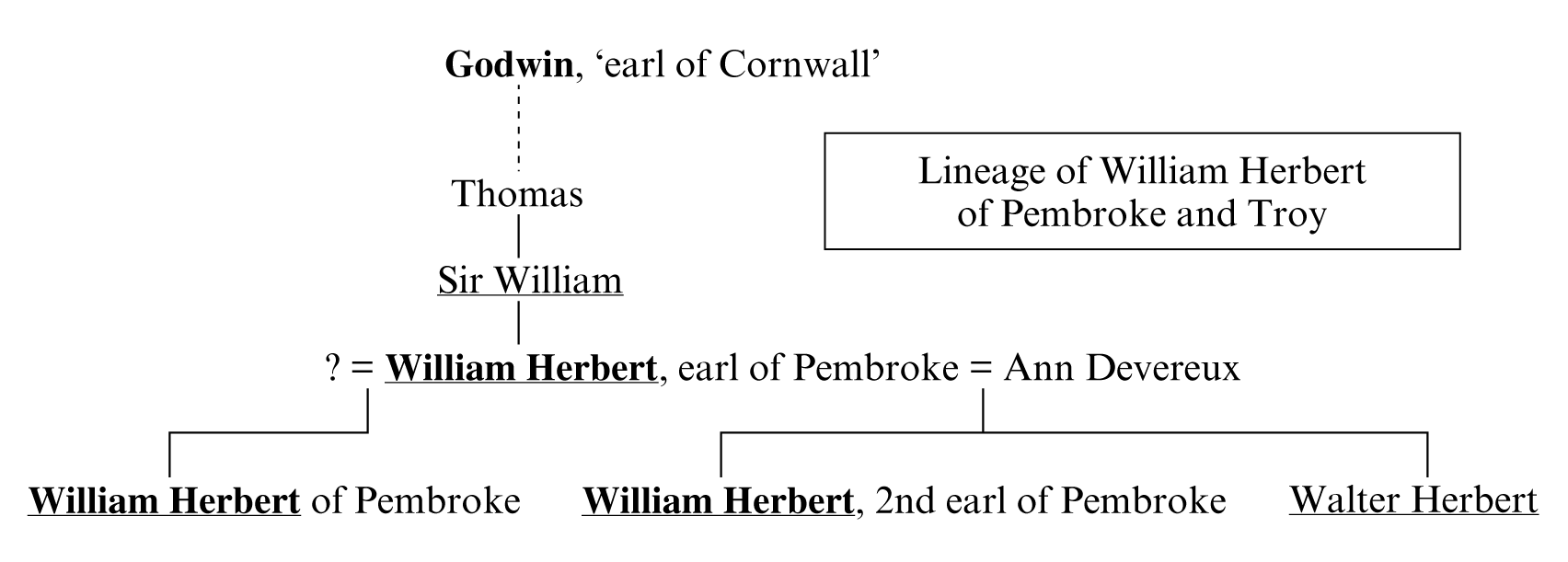William was the recipient of poem 28, a praise poem. No other poems for him are known to have survived.
Lineage
The genealogical table below is based on WG2 ‘Godwin’ 8A1 and A4. Those named in Guto’s poem for William are shown in bold print, and the names of his patrons are underlined.

Lineage of William Herbert of Pembroke and Troy
William was an illegitimate son of William Herbert of Raglan, first earl of Pembroke (d.1469), and therefore a half-brother of the second earl, who was also called William Herbert, and of Walter Herbert. His grandfather was Sir William ap Thomas. All three brothers were patrons of Guto’r Glyn in the 1470s. William must have been an adult by 1462 at the latest (see below), and so he was much older than his half-brother, the second earl of Pembroke, who was born c.1455.
Since there were so many William Herberts in south Wales in the fifteenth century, it can be difficult to distinguish between them. Griffiths (1972: 186) and Thomas (1994: 95) have assembled references to ‘William Herbert, esquire’, suggesting that he was a brother of the first earl, not a son. It may well be that records concerning more than one William Herbert have been confused here. Nevertheless, it appears that Robinson (2002: 37–9) has succeeded in distilling what is relevant to this William Herbert and to show that he was a son of the first earl. It seems that he was the same man as William Herbert of Troy, and that his connection with that place began after his period in Pembroke.
Robinson’s conclusions are accepted here. The text itself makes it quite certain that poem 28 is addressed to a son of the first earl. However, the William Herbert who is addressed is not the second earl himself (cf. 28.14). We must, therefore, be dealing with an illegitimate son of the first earl, which is entirely consistent with Robinson’s reconstruction of the career of William Herbert of Pembroke and Troy.
His career
Before Edward IV’s ascent to the throne in 1461, the lands of the earldom of Pembroke had been in the possession of Jasper Tudor, half-brother of Henry VI. Jasper was forced to flee in 1461 and his lands in south-west Wales were given into the care of Edward’s chief supporter in Wales, William Herbert of Raglan. Herbert made his illegitimate son treasurer and steward of Pembroke sometime before Michaelmas 1462. There is evidence that he was still there in 1467. Things then become obscure and it is uncertain what happened to this William Herbert after his father was executed in July 1469.
However, in the 1470s there is evidence that William was still in the Pembroke area. He was steward of Stackpole Elidor from 1472/3 to 1507/8, and in 1476 he is described as ‘William Herbert of Pembroke the bastard’ in an agreement which he made with his brothers, William Herbert, second earl of Pembroke, and Walter Herbert.
It appears that William Herbert’s connection with Troy began in 1483, when the manor was given to him by his half-brother, the earl (Robinson 2002: 24, 37). Since the document which confirms this arrangement calls him ‘William Herbert esquire, late of Pembroke’, it is unlikely that he was still living in Pembroke. Poem 28 must therefore date before 1483, and indeed before 1479, when the second earl of Pembroke was compelled to exchange his title for that of earl of Huntingdon instead (Thomas 1994: 79). The poem probably belongs to the early 1470s, since the tone of the references to the first earl’s death suggests that it was a fairly recent loss.
William Herbert flourished under the patronage of his legitimate brother. He also won the favour of King Richard III (1483–5) and even Henry VII (1485–1509). He died in 1524 and was buried in Monmouth.
Bibliography
Griffiths, R.A. (1972), The Principality of Wales in the Later Middle Ages: The Structure and Personnel of Government, i: South Wales, 1277–1536 (Cardiff)
Robinson, W.R.B. (2002), ‘The Administration of the Lordship of Monmouth under Henry VII’, The Monmouthshire Antiquary, XVIII: 23–40
Thomas, D.H. (1994), The Herberts of Raglan and the Battle of Edgecote 1469 (Enfield)





